Project Management Plan: Elderly Support Project, Darwin, Australia
VerifiedAdded on 2023/06/04
|17
|3438
|467
Report
AI Summary
This document presents a comprehensive project management plan for establishing an organization dedicated to supporting elderly individuals living alone in Darwin, Australia. The plan outlines the project's feasibility, sustainability, and approval requirements, addressing key strengths, weaknesses, assumptions, and constraints. It includes a detailed quality management section, covering quality items, measurable units, a quality definition table, and analysis of quality management processes such as change control, ISO standards, Total Quality Management, Six Sigma, cost-benefit analysis, and benchmarking. The plan incorporates risk management strategies, cost estimations, and a timeline for project completion, aiming to improve the health and well-being of elderly community members. Desklib offers similar solved assignments and resources for students.
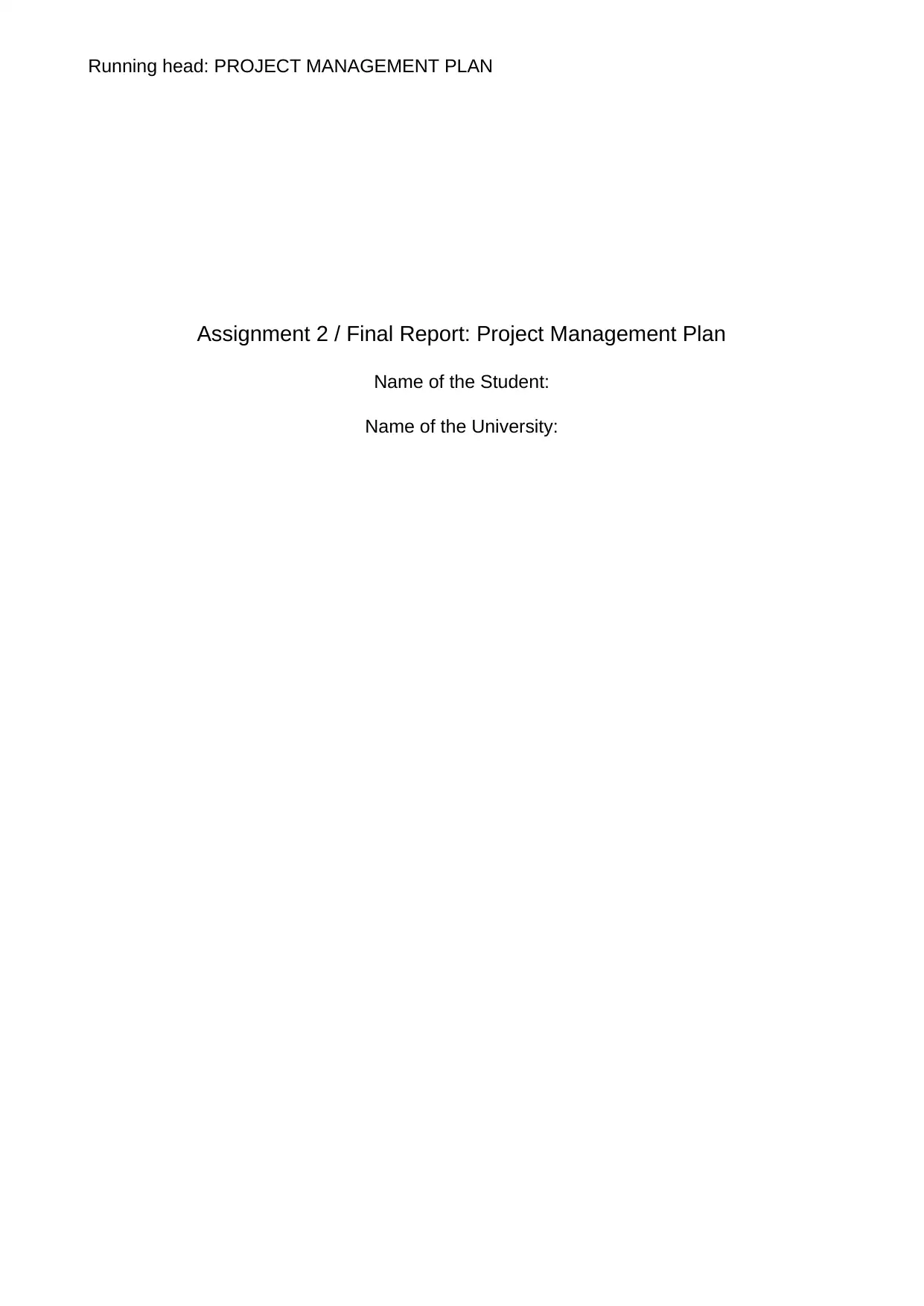
Running head: PROJECT MANAGEMENT PLAN
Assignment 2 / Final Report: Project Management Plan
Name of the Student:
Name of the University:
Assignment 2 / Final Report: Project Management Plan
Name of the Student:
Name of the University:
Paraphrase This Document
Need a fresh take? Get an instant paraphrase of this document with our AI Paraphraser
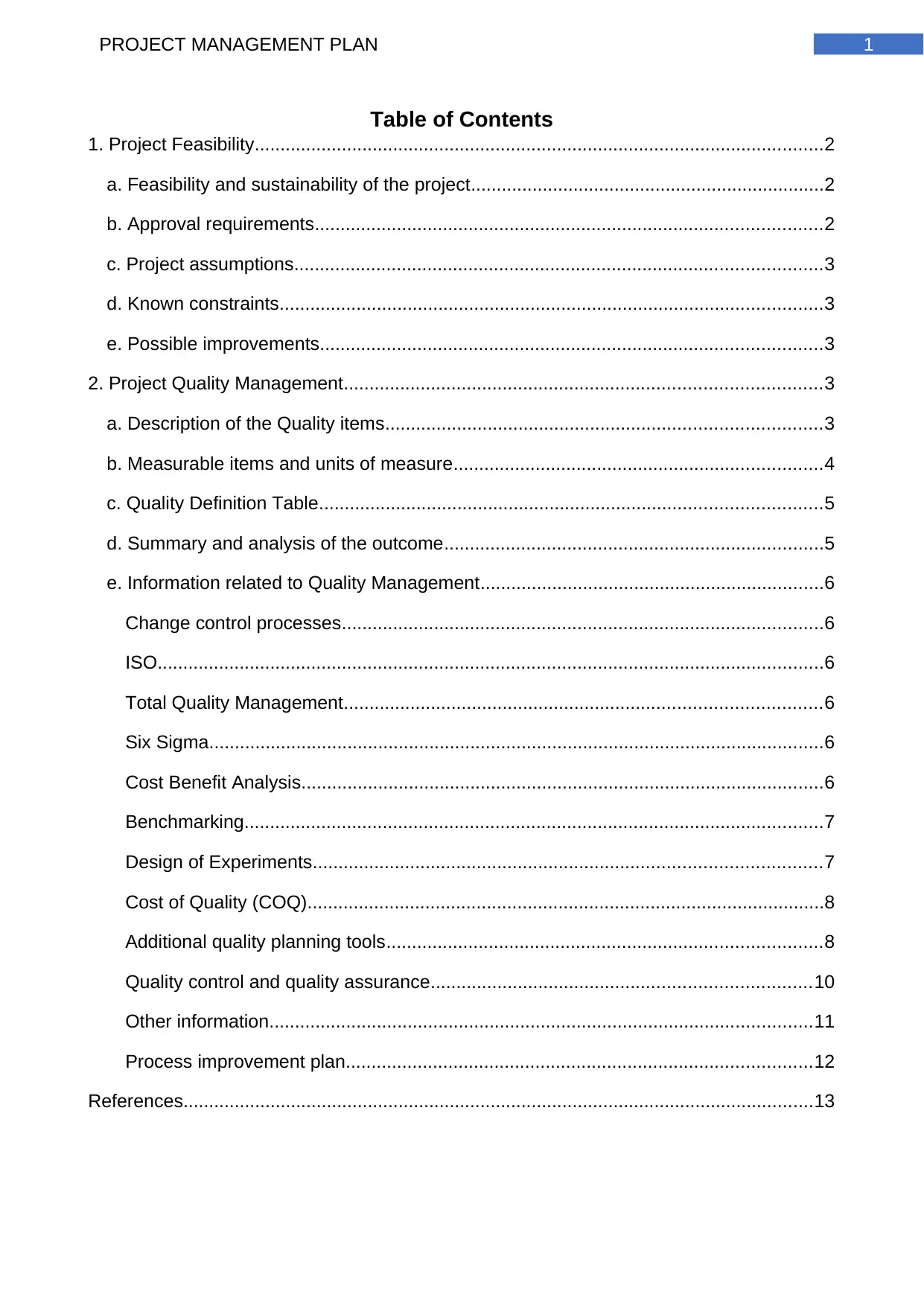
1PROJECT MANAGEMENT PLAN
Table of Contents
1. Project Feasibility...............................................................................................................2
a. Feasibility and sustainability of the project.....................................................................2
b. Approval requirements...................................................................................................2
c. Project assumptions.......................................................................................................3
d. Known constraints..........................................................................................................3
e. Possible improvements..................................................................................................3
2. Project Quality Management.............................................................................................3
a. Description of the Quality items.....................................................................................3
b. Measurable items and units of measure........................................................................4
c. Quality Definition Table..................................................................................................5
d. Summary and analysis of the outcome..........................................................................5
e. Information related to Quality Management...................................................................6
Change control processes..............................................................................................6
ISO..................................................................................................................................6
Total Quality Management.............................................................................................6
Six Sigma........................................................................................................................6
Cost Benefit Analysis......................................................................................................6
Benchmarking.................................................................................................................7
Design of Experiments...................................................................................................7
Cost of Quality (COQ).....................................................................................................8
Additional quality planning tools.....................................................................................8
Quality control and quality assurance..........................................................................10
Other information..........................................................................................................11
Process improvement plan...........................................................................................12
References...........................................................................................................................13
Table of Contents
1. Project Feasibility...............................................................................................................2
a. Feasibility and sustainability of the project.....................................................................2
b. Approval requirements...................................................................................................2
c. Project assumptions.......................................................................................................3
d. Known constraints..........................................................................................................3
e. Possible improvements..................................................................................................3
2. Project Quality Management.............................................................................................3
a. Description of the Quality items.....................................................................................3
b. Measurable items and units of measure........................................................................4
c. Quality Definition Table..................................................................................................5
d. Summary and analysis of the outcome..........................................................................5
e. Information related to Quality Management...................................................................6
Change control processes..............................................................................................6
ISO..................................................................................................................................6
Total Quality Management.............................................................................................6
Six Sigma........................................................................................................................6
Cost Benefit Analysis......................................................................................................6
Benchmarking.................................................................................................................7
Design of Experiments...................................................................................................7
Cost of Quality (COQ).....................................................................................................8
Additional quality planning tools.....................................................................................8
Quality control and quality assurance..........................................................................10
Other information..........................................................................................................11
Process improvement plan...........................................................................................12
References...........................................................................................................................13
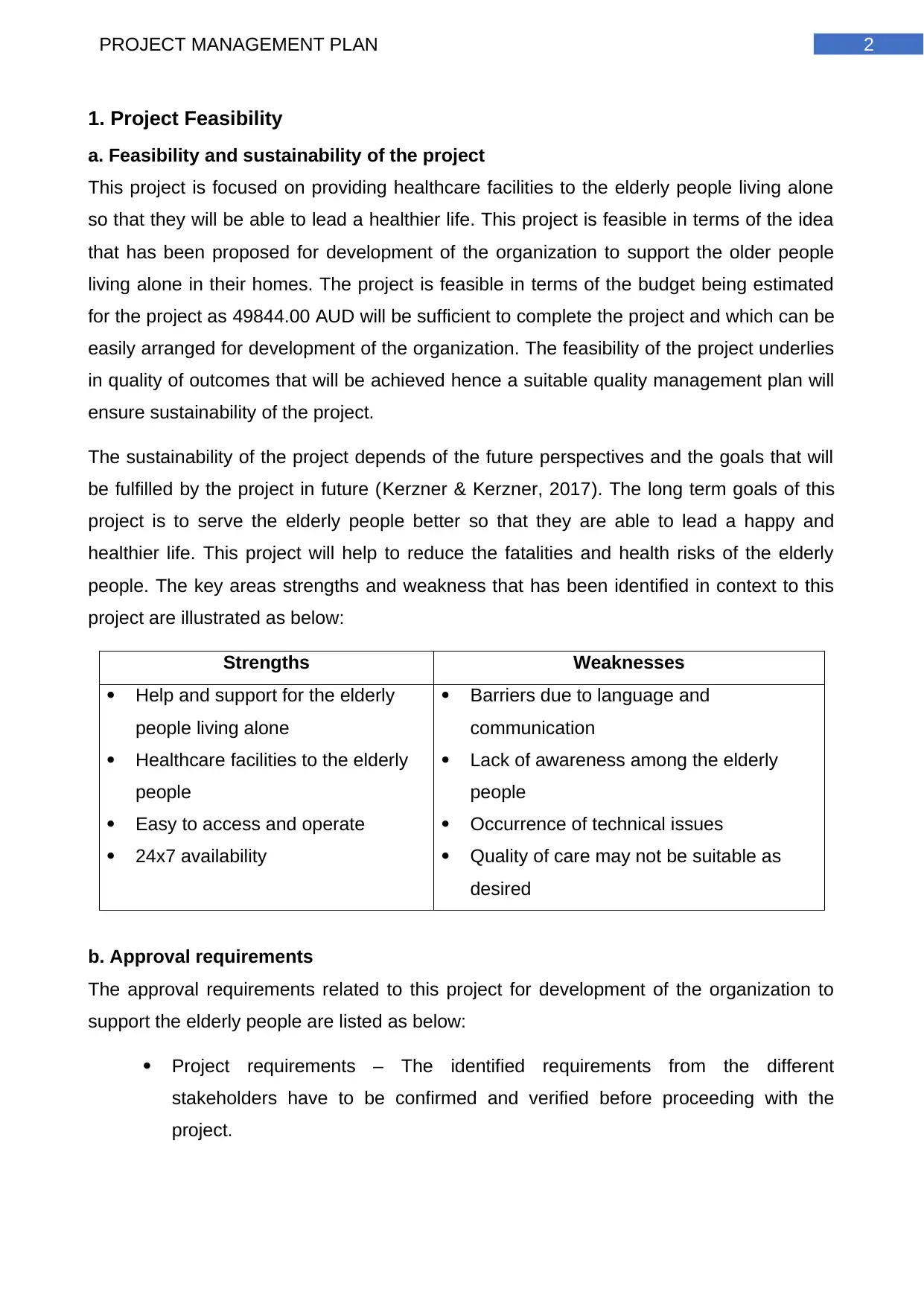
2PROJECT MANAGEMENT PLAN
1. Project Feasibility
a. Feasibility and sustainability of the project
This project is focused on providing healthcare facilities to the elderly people living alone
so that they will be able to lead a healthier life. This project is feasible in terms of the idea
that has been proposed for development of the organization to support the older people
living alone in their homes. The project is feasible in terms of the budget being estimated
for the project as 49844.00 AUD will be sufficient to complete the project and which can be
easily arranged for development of the organization. The feasibility of the project underlies
in quality of outcomes that will be achieved hence a suitable quality management plan will
ensure sustainability of the project.
The sustainability of the project depends of the future perspectives and the goals that will
be fulfilled by the project in future (Kerzner & Kerzner, 2017). The long term goals of this
project is to serve the elderly people better so that they are able to lead a happy and
healthier life. This project will help to reduce the fatalities and health risks of the elderly
people. The key areas strengths and weakness that has been identified in context to this
project are illustrated as below:
Strengths Weaknesses
Help and support for the elderly
people living alone
Healthcare facilities to the elderly
people
Easy to access and operate
24x7 availability
Barriers due to language and
communication
Lack of awareness among the elderly
people
Occurrence of technical issues
Quality of care may not be suitable as
desired
b. Approval requirements
The approval requirements related to this project for development of the organization to
support the elderly people are listed as below:
Project requirements – The identified requirements from the different
stakeholders have to be confirmed and verified before proceeding with the
project.
1. Project Feasibility
a. Feasibility and sustainability of the project
This project is focused on providing healthcare facilities to the elderly people living alone
so that they will be able to lead a healthier life. This project is feasible in terms of the idea
that has been proposed for development of the organization to support the older people
living alone in their homes. The project is feasible in terms of the budget being estimated
for the project as 49844.00 AUD will be sufficient to complete the project and which can be
easily arranged for development of the organization. The feasibility of the project underlies
in quality of outcomes that will be achieved hence a suitable quality management plan will
ensure sustainability of the project.
The sustainability of the project depends of the future perspectives and the goals that will
be fulfilled by the project in future (Kerzner & Kerzner, 2017). The long term goals of this
project is to serve the elderly people better so that they are able to lead a happy and
healthier life. This project will help to reduce the fatalities and health risks of the elderly
people. The key areas strengths and weakness that has been identified in context to this
project are illustrated as below:
Strengths Weaknesses
Help and support for the elderly
people living alone
Healthcare facilities to the elderly
people
Easy to access and operate
24x7 availability
Barriers due to language and
communication
Lack of awareness among the elderly
people
Occurrence of technical issues
Quality of care may not be suitable as
desired
b. Approval requirements
The approval requirements related to this project for development of the organization to
support the elderly people are listed as below:
Project requirements – The identified requirements from the different
stakeholders have to be confirmed and verified before proceeding with the
project.
⊘ This is a preview!⊘
Do you want full access?
Subscribe today to unlock all pages.

Trusted by 1+ million students worldwide
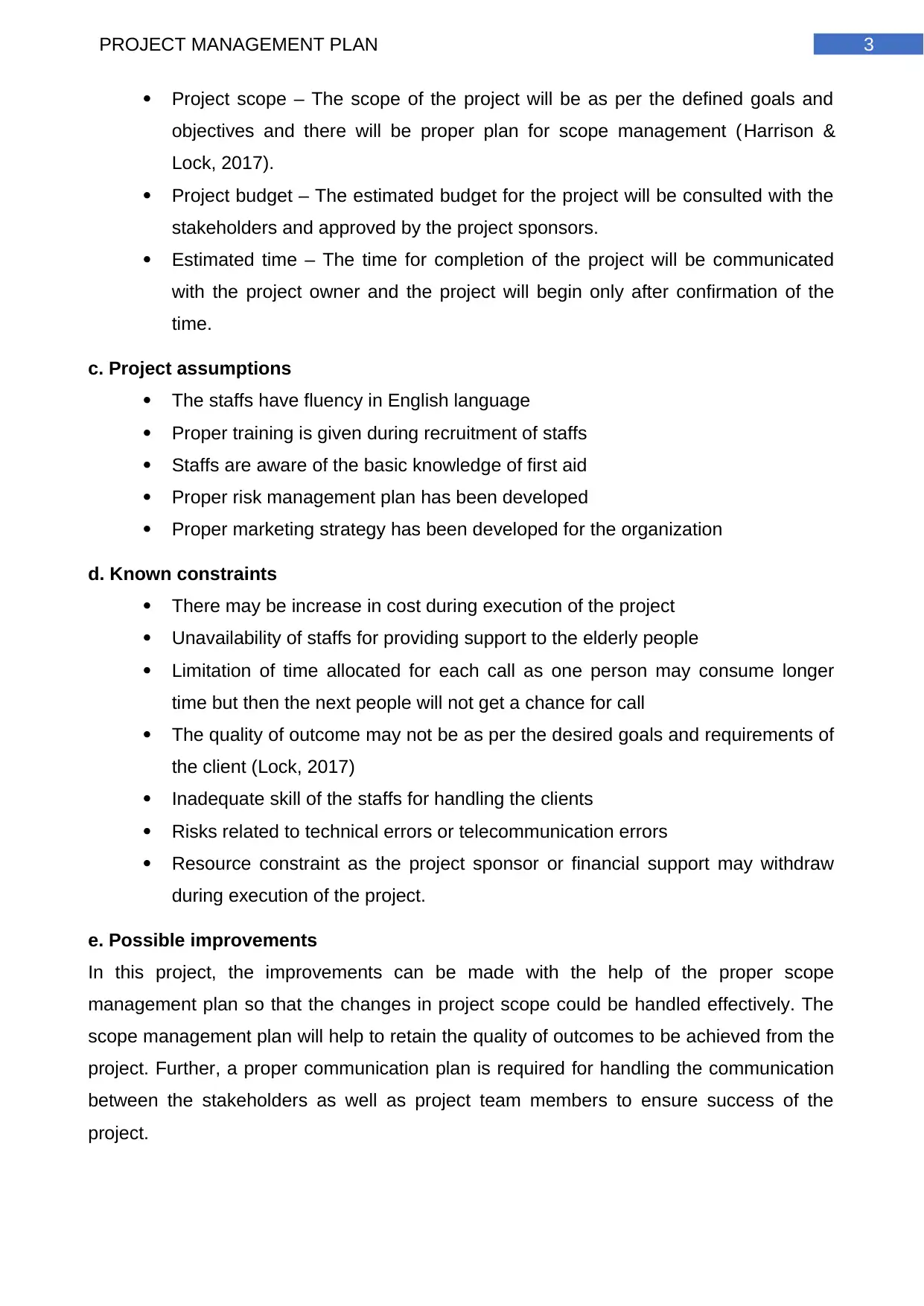
3PROJECT MANAGEMENT PLAN
Project scope – The scope of the project will be as per the defined goals and
objectives and there will be proper plan for scope management (Harrison &
Lock, 2017).
Project budget – The estimated budget for the project will be consulted with the
stakeholders and approved by the project sponsors.
Estimated time – The time for completion of the project will be communicated
with the project owner and the project will begin only after confirmation of the
time.
c. Project assumptions
The staffs have fluency in English language
Proper training is given during recruitment of staffs
Staffs are aware of the basic knowledge of first aid
Proper risk management plan has been developed
Proper marketing strategy has been developed for the organization
d. Known constraints
There may be increase in cost during execution of the project
Unavailability of staffs for providing support to the elderly people
Limitation of time allocated for each call as one person may consume longer
time but then the next people will not get a chance for call
The quality of outcome may not be as per the desired goals and requirements of
the client (Lock, 2017)
Inadequate skill of the staffs for handling the clients
Risks related to technical errors or telecommunication errors
Resource constraint as the project sponsor or financial support may withdraw
during execution of the project.
e. Possible improvements
In this project, the improvements can be made with the help of the proper scope
management plan so that the changes in project scope could be handled effectively. The
scope management plan will help to retain the quality of outcomes to be achieved from the
project. Further, a proper communication plan is required for handling the communication
between the stakeholders as well as project team members to ensure success of the
project.
Project scope – The scope of the project will be as per the defined goals and
objectives and there will be proper plan for scope management (Harrison &
Lock, 2017).
Project budget – The estimated budget for the project will be consulted with the
stakeholders and approved by the project sponsors.
Estimated time – The time for completion of the project will be communicated
with the project owner and the project will begin only after confirmation of the
time.
c. Project assumptions
The staffs have fluency in English language
Proper training is given during recruitment of staffs
Staffs are aware of the basic knowledge of first aid
Proper risk management plan has been developed
Proper marketing strategy has been developed for the organization
d. Known constraints
There may be increase in cost during execution of the project
Unavailability of staffs for providing support to the elderly people
Limitation of time allocated for each call as one person may consume longer
time but then the next people will not get a chance for call
The quality of outcome may not be as per the desired goals and requirements of
the client (Lock, 2017)
Inadequate skill of the staffs for handling the clients
Risks related to technical errors or telecommunication errors
Resource constraint as the project sponsor or financial support may withdraw
during execution of the project.
e. Possible improvements
In this project, the improvements can be made with the help of the proper scope
management plan so that the changes in project scope could be handled effectively. The
scope management plan will help to retain the quality of outcomes to be achieved from the
project. Further, a proper communication plan is required for handling the communication
between the stakeholders as well as project team members to ensure success of the
project.
Paraphrase This Document
Need a fresh take? Get an instant paraphrase of this document with our AI Paraphraser
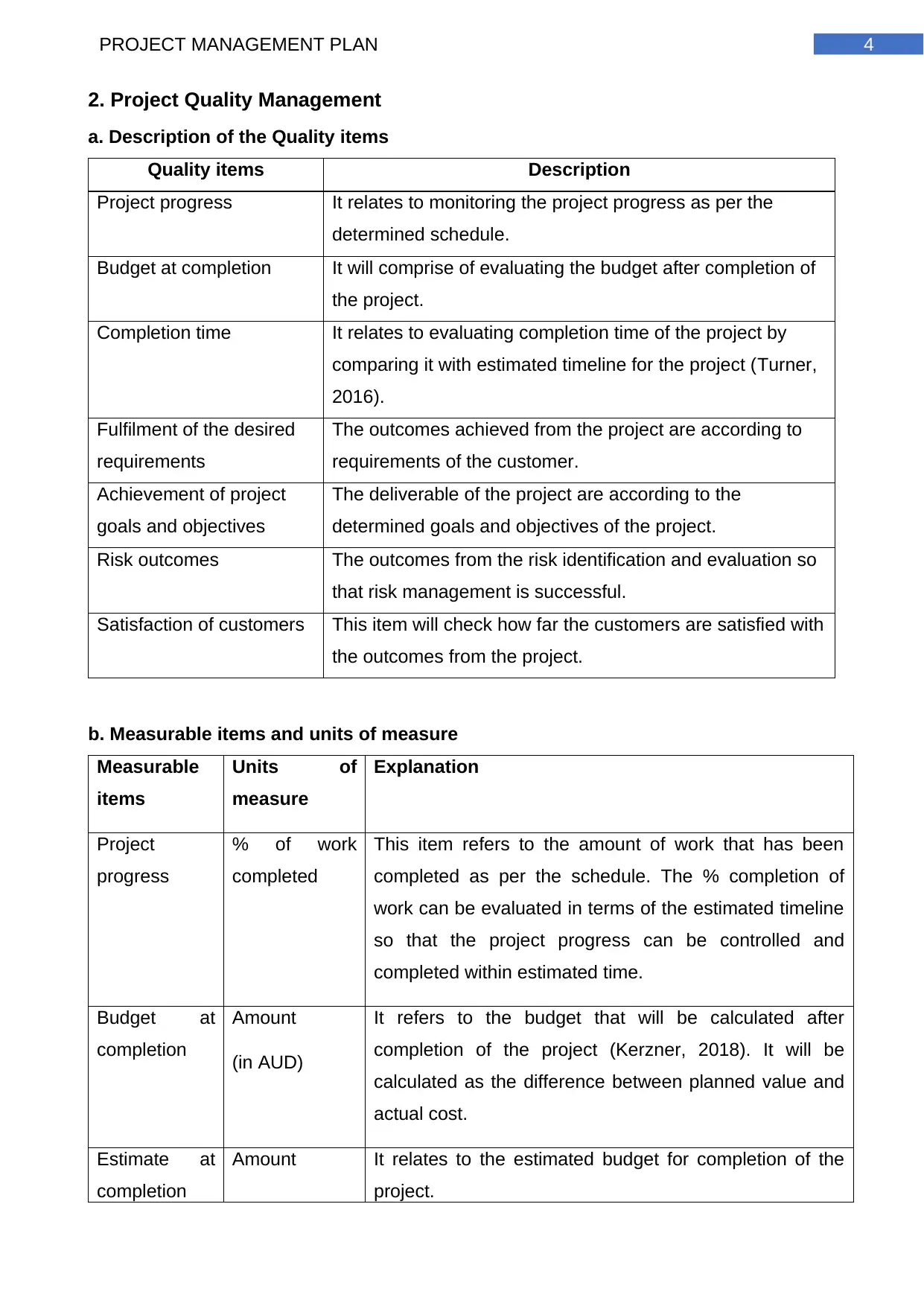
4PROJECT MANAGEMENT PLAN
2. Project Quality Management
a. Description of the Quality items
Quality items Description
Project progress It relates to monitoring the project progress as per the
determined schedule.
Budget at completion It will comprise of evaluating the budget after completion of
the project.
Completion time It relates to evaluating completion time of the project by
comparing it with estimated timeline for the project (Turner,
2016).
Fulfilment of the desired
requirements
The outcomes achieved from the project are according to
requirements of the customer.
Achievement of project
goals and objectives
The deliverable of the project are according to the
determined goals and objectives of the project.
Risk outcomes The outcomes from the risk identification and evaluation so
that risk management is successful.
Satisfaction of customers This item will check how far the customers are satisfied with
the outcomes from the project.
b. Measurable items and units of measure
Measurable
items
Units of
measure
Explanation
Project
progress
% of work
completed
This item refers to the amount of work that has been
completed as per the schedule. The % completion of
work can be evaluated in terms of the estimated timeline
so that the project progress can be controlled and
completed within estimated time.
Budget at
completion
Amount
(in AUD)
It refers to the budget that will be calculated after
completion of the project (Kerzner, 2018). It will be
calculated as the difference between planned value and
actual cost.
Estimate at
completion
Amount It relates to the estimated budget for completion of the
project.
2. Project Quality Management
a. Description of the Quality items
Quality items Description
Project progress It relates to monitoring the project progress as per the
determined schedule.
Budget at completion It will comprise of evaluating the budget after completion of
the project.
Completion time It relates to evaluating completion time of the project by
comparing it with estimated timeline for the project (Turner,
2016).
Fulfilment of the desired
requirements
The outcomes achieved from the project are according to
requirements of the customer.
Achievement of project
goals and objectives
The deliverable of the project are according to the
determined goals and objectives of the project.
Risk outcomes The outcomes from the risk identification and evaluation so
that risk management is successful.
Satisfaction of customers This item will check how far the customers are satisfied with
the outcomes from the project.
b. Measurable items and units of measure
Measurable
items
Units of
measure
Explanation
Project
progress
% of work
completed
This item refers to the amount of work that has been
completed as per the schedule. The % completion of
work can be evaluated in terms of the estimated timeline
so that the project progress can be controlled and
completed within estimated time.
Budget at
completion
Amount
(in AUD)
It refers to the budget that will be calculated after
completion of the project (Kerzner, 2018). It will be
calculated as the difference between planned value and
actual cost.
Estimate at
completion
Amount It relates to the estimated budget for completion of the
project.
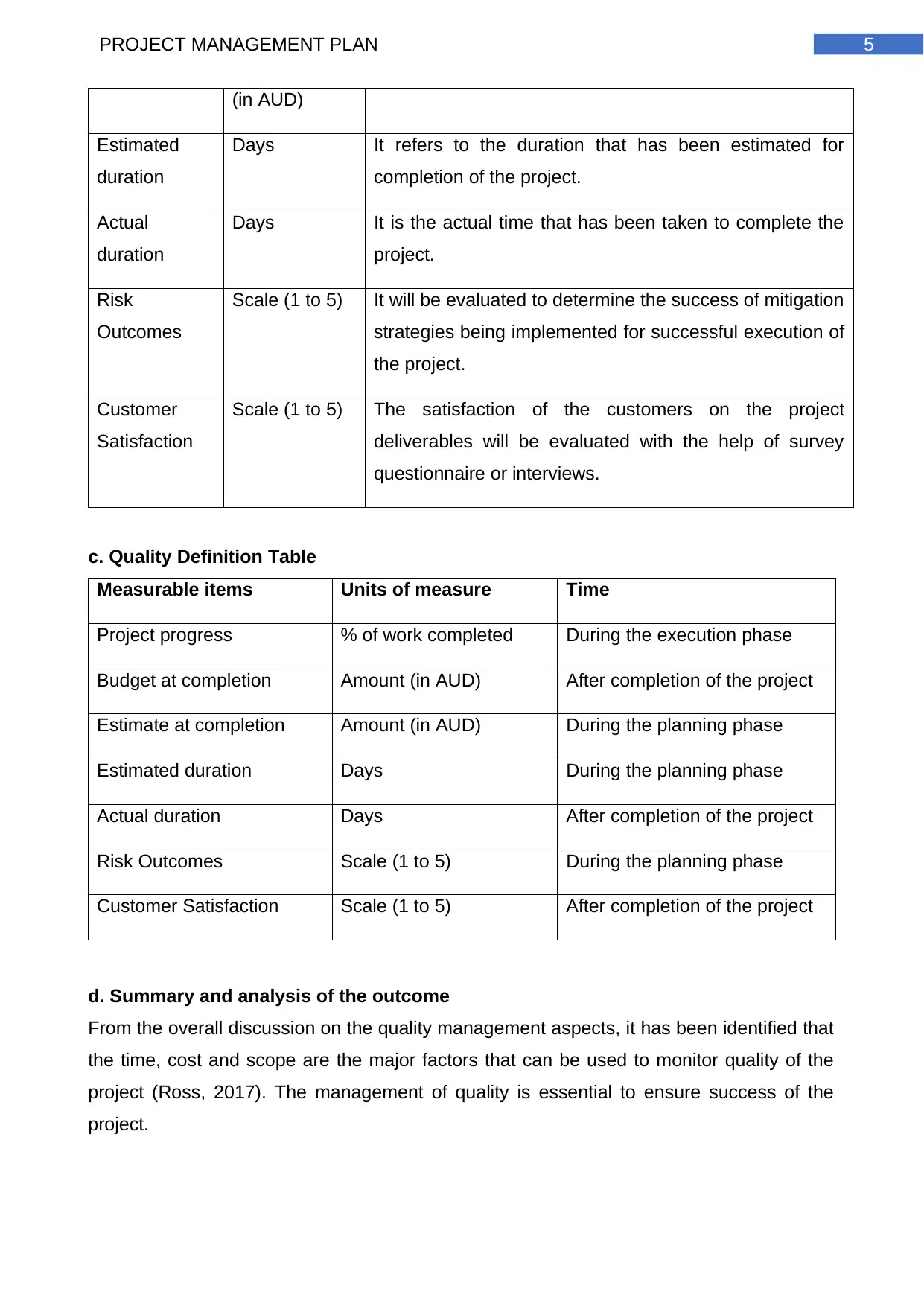
5PROJECT MANAGEMENT PLAN
(in AUD)
Estimated
duration
Days It refers to the duration that has been estimated for
completion of the project.
Actual
duration
Days It is the actual time that has been taken to complete the
project.
Risk
Outcomes
Scale (1 to 5) It will be evaluated to determine the success of mitigation
strategies being implemented for successful execution of
the project.
Customer
Satisfaction
Scale (1 to 5) The satisfaction of the customers on the project
deliverables will be evaluated with the help of survey
questionnaire or interviews.
c. Quality Definition Table
Measurable items Units of measure Time
Project progress % of work completed During the execution phase
Budget at completion Amount (in AUD) After completion of the project
Estimate at completion Amount (in AUD) During the planning phase
Estimated duration Days During the planning phase
Actual duration Days After completion of the project
Risk Outcomes Scale (1 to 5) During the planning phase
Customer Satisfaction Scale (1 to 5) After completion of the project
d. Summary and analysis of the outcome
From the overall discussion on the quality management aspects, it has been identified that
the time, cost and scope are the major factors that can be used to monitor quality of the
project (Ross, 2017). The management of quality is essential to ensure success of the
project.
(in AUD)
Estimated
duration
Days It refers to the duration that has been estimated for
completion of the project.
Actual
duration
Days It is the actual time that has been taken to complete the
project.
Risk
Outcomes
Scale (1 to 5) It will be evaluated to determine the success of mitigation
strategies being implemented for successful execution of
the project.
Customer
Satisfaction
Scale (1 to 5) The satisfaction of the customers on the project
deliverables will be evaluated with the help of survey
questionnaire or interviews.
c. Quality Definition Table
Measurable items Units of measure Time
Project progress % of work completed During the execution phase
Budget at completion Amount (in AUD) After completion of the project
Estimate at completion Amount (in AUD) During the planning phase
Estimated duration Days During the planning phase
Actual duration Days After completion of the project
Risk Outcomes Scale (1 to 5) During the planning phase
Customer Satisfaction Scale (1 to 5) After completion of the project
d. Summary and analysis of the outcome
From the overall discussion on the quality management aspects, it has been identified that
the time, cost and scope are the major factors that can be used to monitor quality of the
project (Ross, 2017). The management of quality is essential to ensure success of the
project.
⊘ This is a preview!⊘
Do you want full access?
Subscribe today to unlock all pages.

Trusted by 1+ million students worldwide
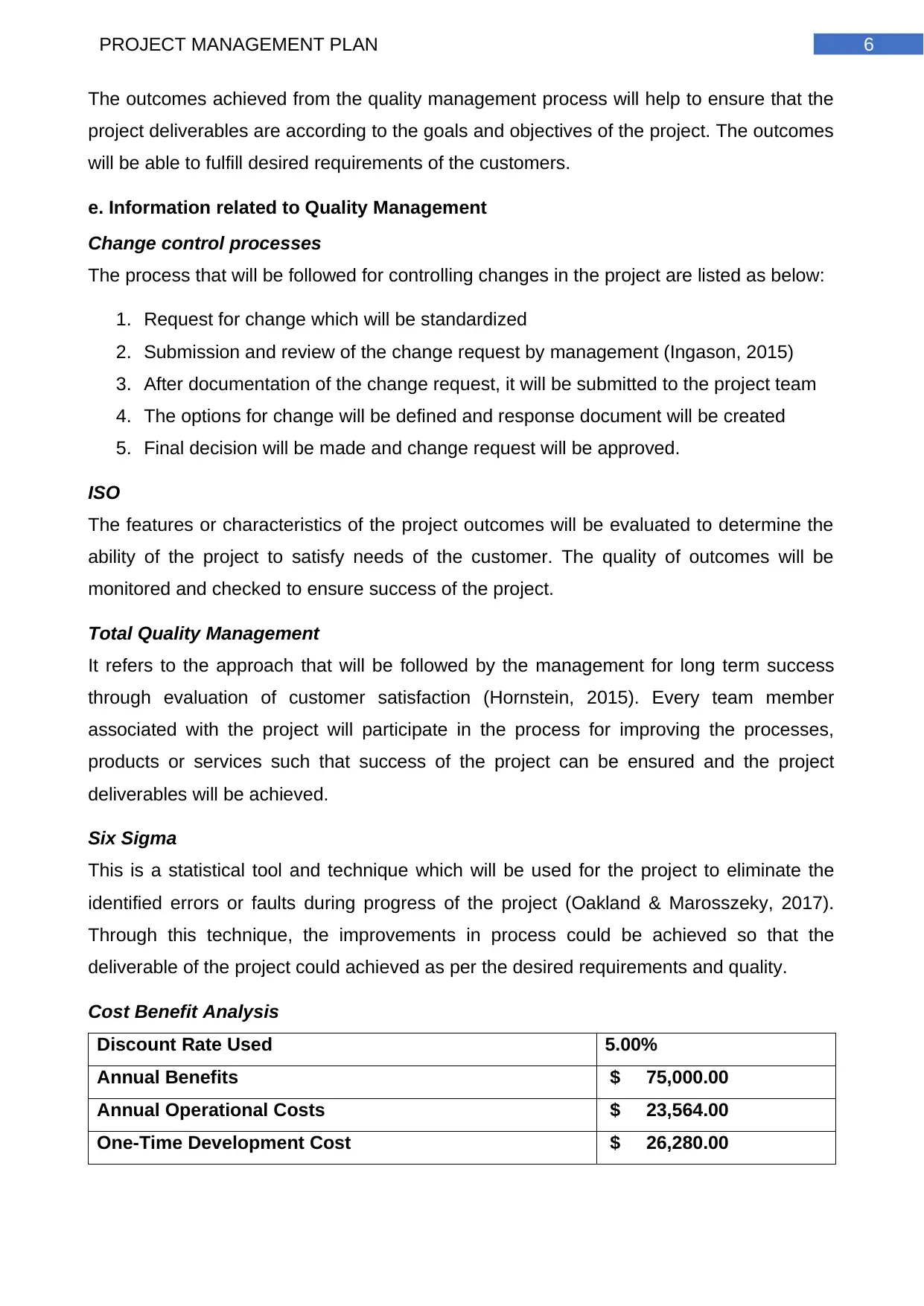
6PROJECT MANAGEMENT PLAN
The outcomes achieved from the quality management process will help to ensure that the
project deliverables are according to the goals and objectives of the project. The outcomes
will be able to fulfill desired requirements of the customers.
e. Information related to Quality Management
Change control processes
The process that will be followed for controlling changes in the project are listed as below:
1. Request for change which will be standardized
2. Submission and review of the change request by management (Ingason, 2015)
3. After documentation of the change request, it will be submitted to the project team
4. The options for change will be defined and response document will be created
5. Final decision will be made and change request will be approved.
ISO
The features or characteristics of the project outcomes will be evaluated to determine the
ability of the project to satisfy needs of the customer. The quality of outcomes will be
monitored and checked to ensure success of the project.
Total Quality Management
It refers to the approach that will be followed by the management for long term success
through evaluation of customer satisfaction (Hornstein, 2015). Every team member
associated with the project will participate in the process for improving the processes,
products or services such that success of the project can be ensured and the project
deliverables will be achieved.
Six Sigma
This is a statistical tool and technique which will be used for the project to eliminate the
identified errors or faults during progress of the project (Oakland & Marosszeky, 2017).
Through this technique, the improvements in process could be achieved so that the
deliverable of the project could achieved as per the desired requirements and quality.
Cost Benefit Analysis
Discount Rate Used 5.00%
Annual Benefits $ 75,000.00
Annual Operational Costs $ 23,564.00
One-Time Development Cost $ 26,280.00
The outcomes achieved from the quality management process will help to ensure that the
project deliverables are according to the goals and objectives of the project. The outcomes
will be able to fulfill desired requirements of the customers.
e. Information related to Quality Management
Change control processes
The process that will be followed for controlling changes in the project are listed as below:
1. Request for change which will be standardized
2. Submission and review of the change request by management (Ingason, 2015)
3. After documentation of the change request, it will be submitted to the project team
4. The options for change will be defined and response document will be created
5. Final decision will be made and change request will be approved.
ISO
The features or characteristics of the project outcomes will be evaluated to determine the
ability of the project to satisfy needs of the customer. The quality of outcomes will be
monitored and checked to ensure success of the project.
Total Quality Management
It refers to the approach that will be followed by the management for long term success
through evaluation of customer satisfaction (Hornstein, 2015). Every team member
associated with the project will participate in the process for improving the processes,
products or services such that success of the project can be ensured and the project
deliverables will be achieved.
Six Sigma
This is a statistical tool and technique which will be used for the project to eliminate the
identified errors or faults during progress of the project (Oakland & Marosszeky, 2017).
Through this technique, the improvements in process could be achieved so that the
deliverable of the project could achieved as per the desired requirements and quality.
Cost Benefit Analysis
Discount Rate Used 5.00%
Annual Benefits $ 75,000.00
Annual Operational Costs $ 23,564.00
One-Time Development Cost $ 26,280.00
Paraphrase This Document
Need a fresh take? Get an instant paraphrase of this document with our AI Paraphraser
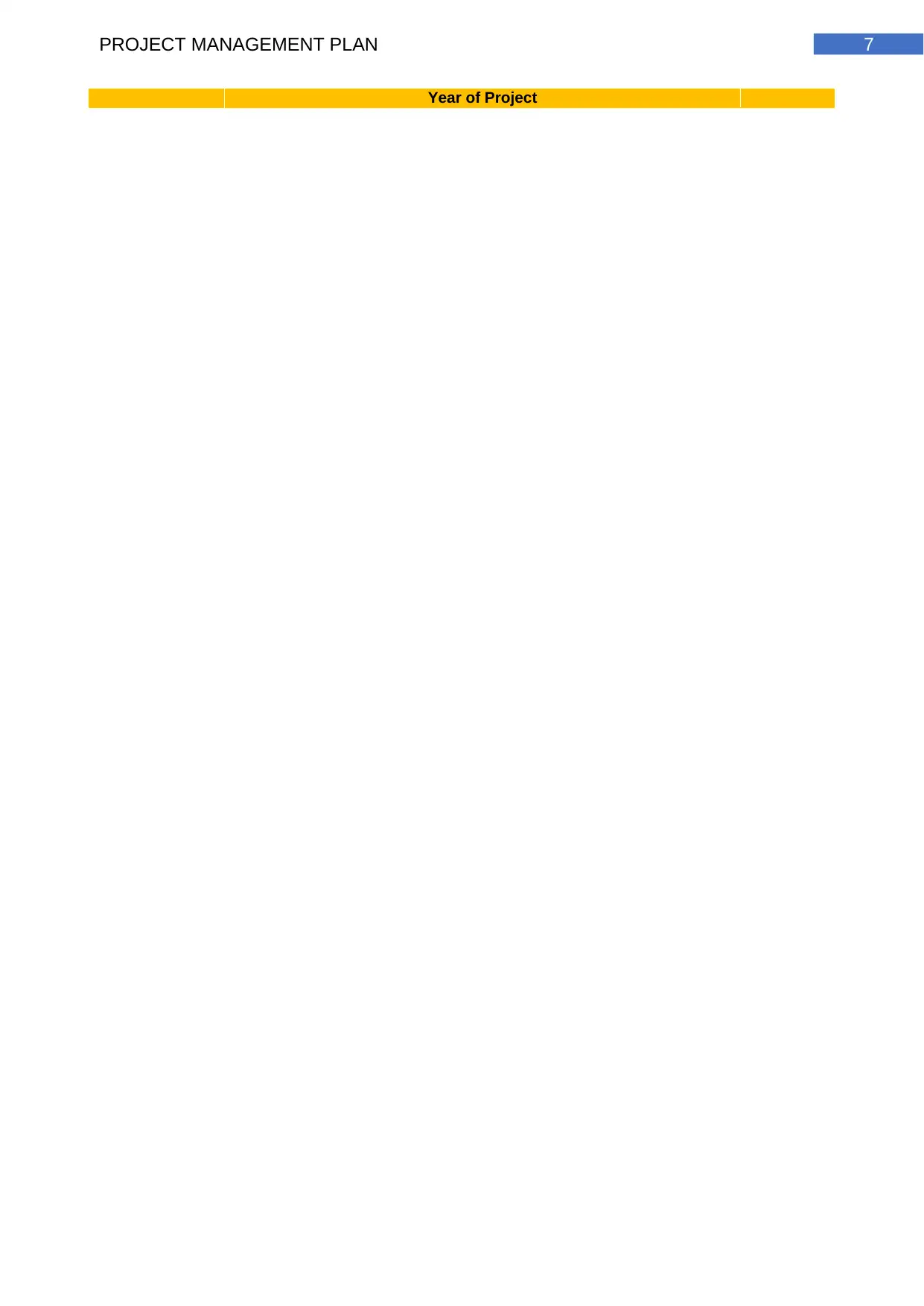
7PROJECT MANAGEMENT PLAN
Year of Project
Year of Project
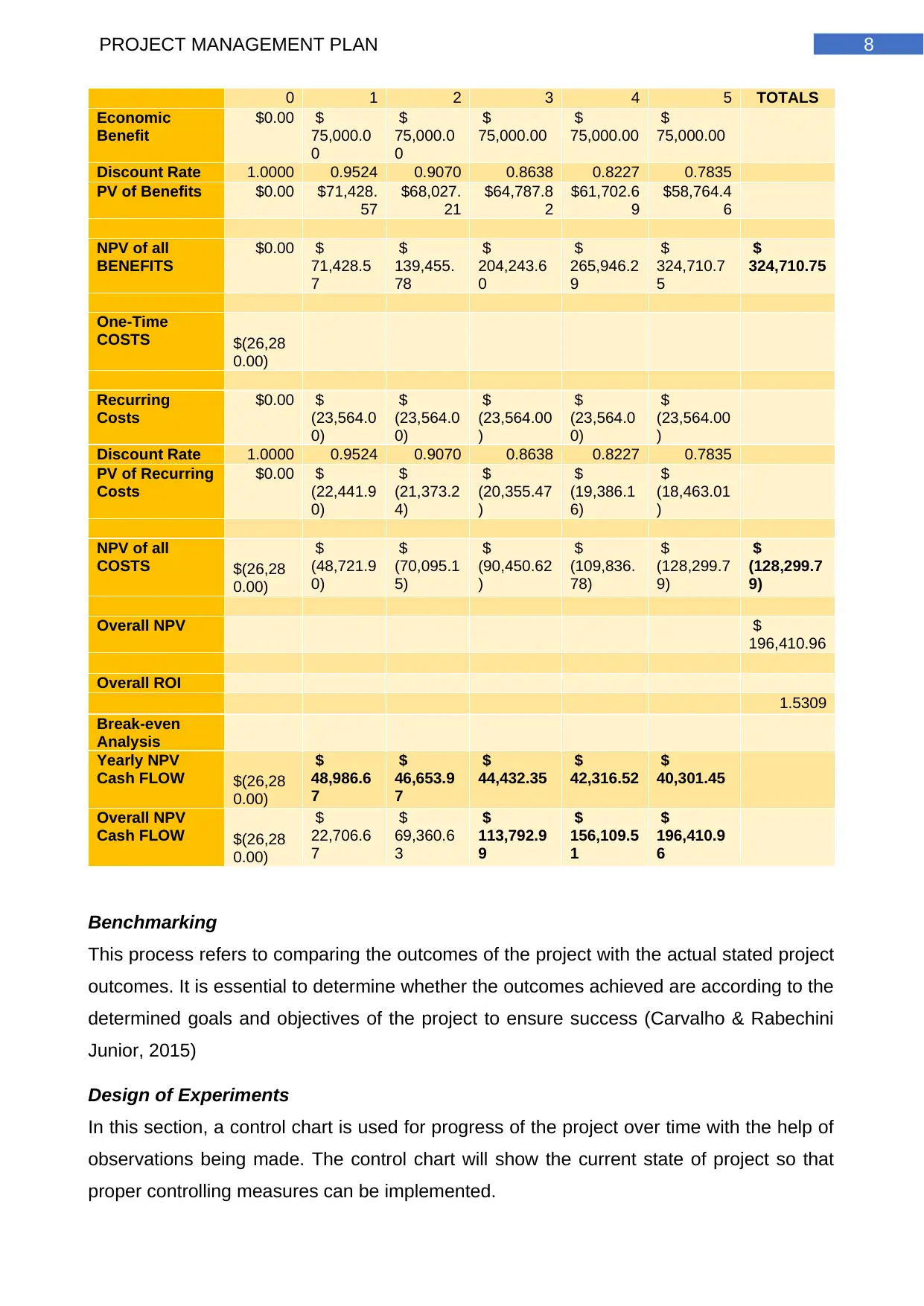
8PROJECT MANAGEMENT PLAN
0 1 2 3 4 5 TOTALS
Economic
Benefit
$0.00 $
75,000.0
0
$
75,000.0
0
$
75,000.00
$
75,000.00
$
75,000.00
Discount Rate 1.0000 0.9524 0.9070 0.8638 0.8227 0.7835
PV of Benefits $0.00 $71,428.
57
$68,027.
21
$64,787.8
2
$61,702.6
9
$58,764.4
6
NPV of all
BENEFITS
$0.00 $
71,428.5
7
$
139,455.
78
$
204,243.6
0
$
265,946.2
9
$
324,710.7
5
$
324,710.75
One-Time
COSTS $(26,28
0.00)
Recurring
Costs
$0.00 $
(23,564.0
0)
$
(23,564.0
0)
$
(23,564.00
)
$
(23,564.0
0)
$
(23,564.00
)
Discount Rate 1.0000 0.9524 0.9070 0.8638 0.8227 0.7835
PV of Recurring
Costs
$0.00 $
(22,441.9
0)
$
(21,373.2
4)
$
(20,355.47
)
$
(19,386.1
6)
$
(18,463.01
)
NPV of all
COSTS $(26,28
0.00)
$
(48,721.9
0)
$
(70,095.1
5)
$
(90,450.62
)
$
(109,836.
78)
$
(128,299.7
9)
$
(128,299.7
9)
Overall NPV $
196,410.96
Overall ROI
1.5309
Break-even
Analysis
Yearly NPV
Cash FLOW $(26,28
0.00)
$
48,986.6
7
$
46,653.9
7
$
44,432.35
$
42,316.52
$
40,301.45
Overall NPV
Cash FLOW $(26,28
0.00)
$
22,706.6
7
$
69,360.6
3
$
113,792.9
9
$
156,109.5
1
$
196,410.9
6
Benchmarking
This process refers to comparing the outcomes of the project with the actual stated project
outcomes. It is essential to determine whether the outcomes achieved are according to the
determined goals and objectives of the project to ensure success (Carvalho & Rabechini
Junior, 2015)
Design of Experiments
In this section, a control chart is used for progress of the project over time with the help of
observations being made. The control chart will show the current state of project so that
proper controlling measures can be implemented.
0 1 2 3 4 5 TOTALS
Economic
Benefit
$0.00 $
75,000.0
0
$
75,000.0
0
$
75,000.00
$
75,000.00
$
75,000.00
Discount Rate 1.0000 0.9524 0.9070 0.8638 0.8227 0.7835
PV of Benefits $0.00 $71,428.
57
$68,027.
21
$64,787.8
2
$61,702.6
9
$58,764.4
6
NPV of all
BENEFITS
$0.00 $
71,428.5
7
$
139,455.
78
$
204,243.6
0
$
265,946.2
9
$
324,710.7
5
$
324,710.75
One-Time
COSTS $(26,28
0.00)
Recurring
Costs
$0.00 $
(23,564.0
0)
$
(23,564.0
0)
$
(23,564.00
)
$
(23,564.0
0)
$
(23,564.00
)
Discount Rate 1.0000 0.9524 0.9070 0.8638 0.8227 0.7835
PV of Recurring
Costs
$0.00 $
(22,441.9
0)
$
(21,373.2
4)
$
(20,355.47
)
$
(19,386.1
6)
$
(18,463.01
)
NPV of all
COSTS $(26,28
0.00)
$
(48,721.9
0)
$
(70,095.1
5)
$
(90,450.62
)
$
(109,836.
78)
$
(128,299.7
9)
$
(128,299.7
9)
Overall NPV $
196,410.96
Overall ROI
1.5309
Break-even
Analysis
Yearly NPV
Cash FLOW $(26,28
0.00)
$
48,986.6
7
$
46,653.9
7
$
44,432.35
$
42,316.52
$
40,301.45
Overall NPV
Cash FLOW $(26,28
0.00)
$
22,706.6
7
$
69,360.6
3
$
113,792.9
9
$
156,109.5
1
$
196,410.9
6
Benchmarking
This process refers to comparing the outcomes of the project with the actual stated project
outcomes. It is essential to determine whether the outcomes achieved are according to the
determined goals and objectives of the project to ensure success (Carvalho & Rabechini
Junior, 2015)
Design of Experiments
In this section, a control chart is used for progress of the project over time with the help of
observations being made. The control chart will show the current state of project so that
proper controlling measures can be implemented.
⊘ This is a preview!⊘
Do you want full access?
Subscribe today to unlock all pages.

Trusted by 1+ million students worldwide
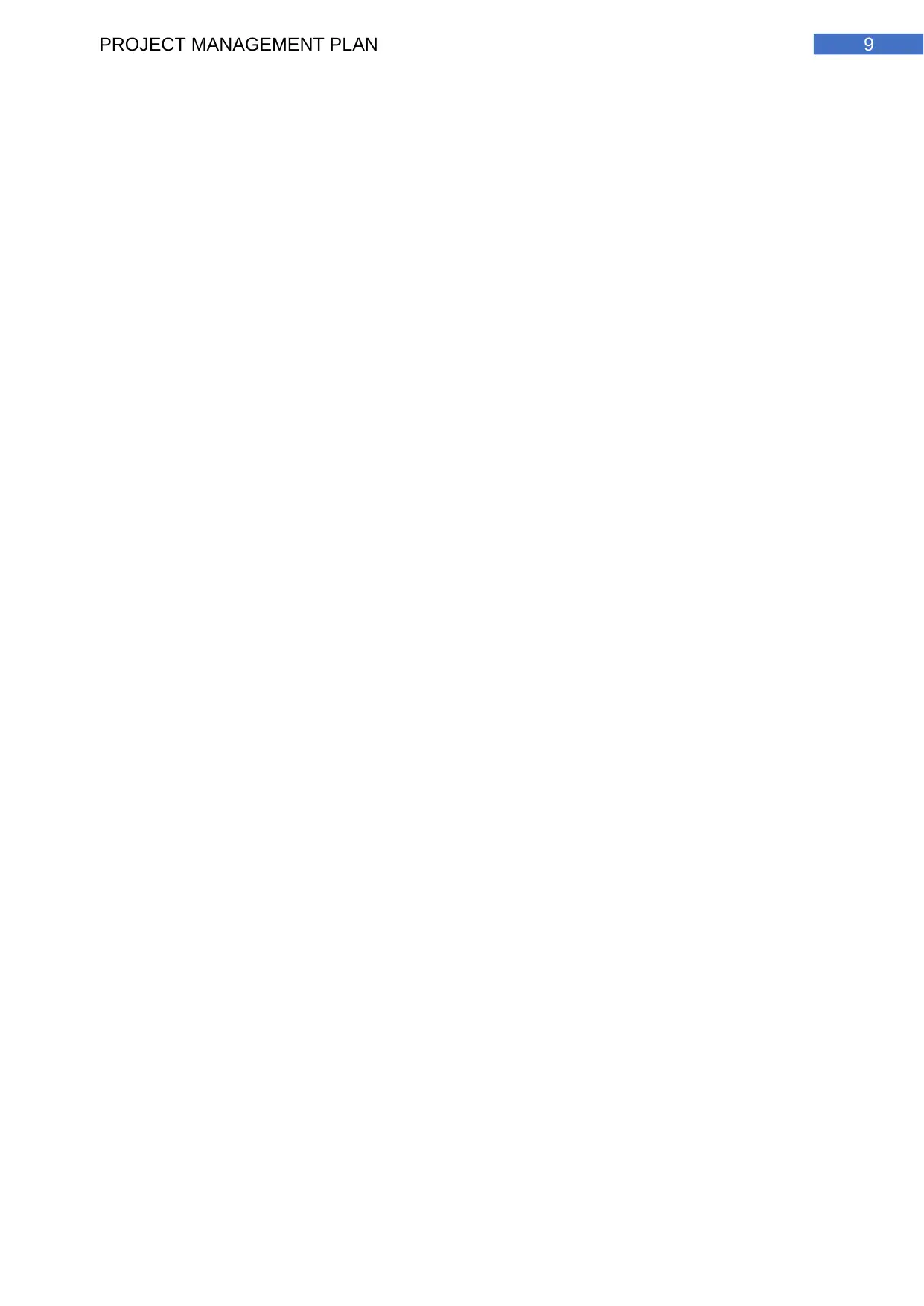
9PROJECT MANAGEMENT PLAN
Paraphrase This Document
Need a fresh take? Get an instant paraphrase of this document with our AI Paraphraser
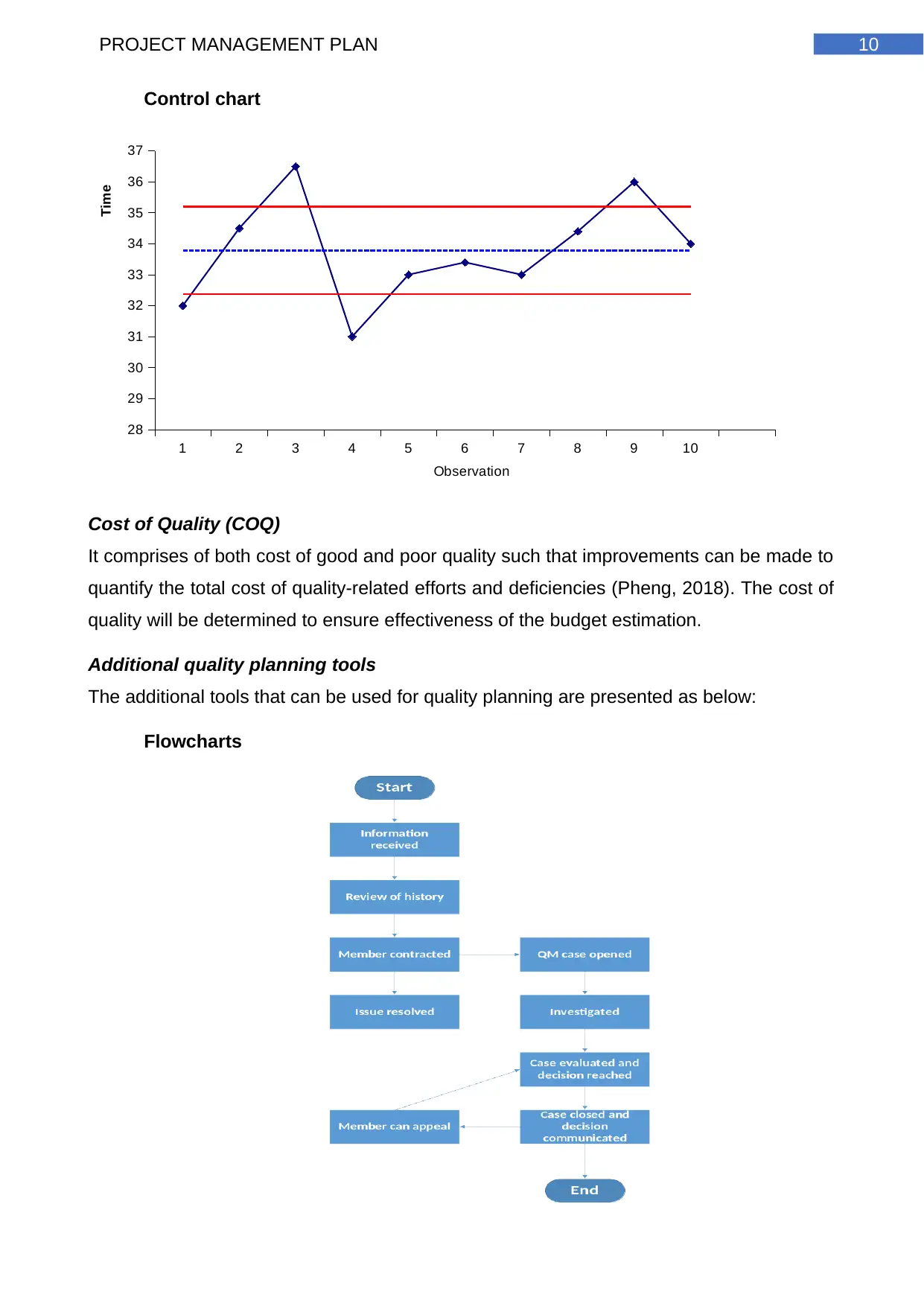
10PROJECT MANAGEMENT PLAN
Control chart
1 2 3 4 5 6 7 8 9 10
28
29
30
31
32
33
34
35
36
37
Observation
Time
Cost of Quality (COQ)
It comprises of both cost of good and poor quality such that improvements can be made to
quantify the total cost of quality-related efforts and deficiencies (Pheng, 2018). The cost of
quality will be determined to ensure effectiveness of the budget estimation.
Additional quality planning tools
The additional tools that can be used for quality planning are presented as below:
Flowcharts
Control chart
1 2 3 4 5 6 7 8 9 10
28
29
30
31
32
33
34
35
36
37
Observation
Time
Cost of Quality (COQ)
It comprises of both cost of good and poor quality such that improvements can be made to
quantify the total cost of quality-related efforts and deficiencies (Pheng, 2018). The cost of
quality will be determined to ensure effectiveness of the budget estimation.
Additional quality planning tools
The additional tools that can be used for quality planning are presented as below:
Flowcharts
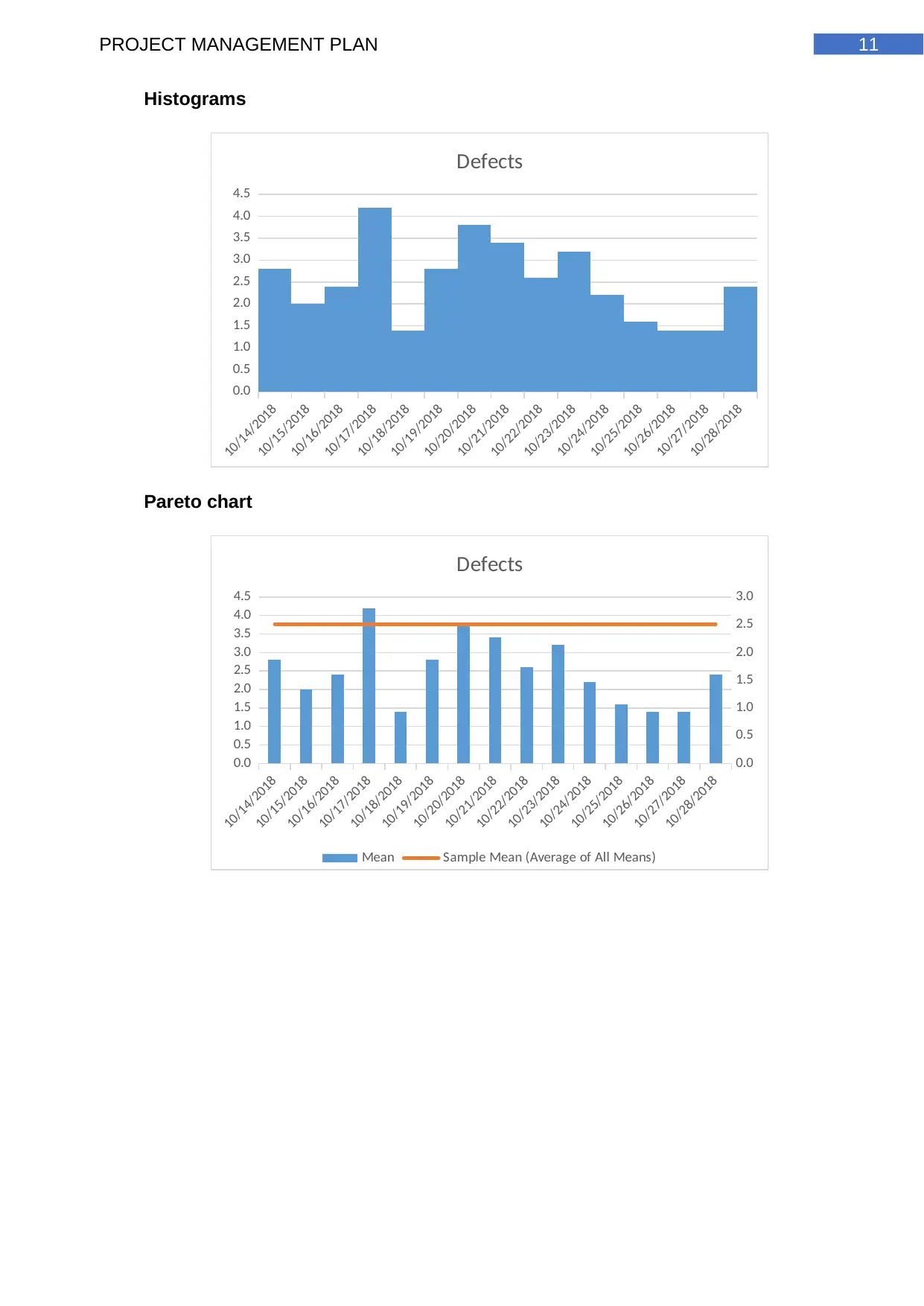
11PROJECT MANAGEMENT PLAN
Histograms
10/14/2018
10/15/2018
10/16/2018
10/17/2018
10/18/2018
10/19/2018
10/20/2018
10/21/2018
10/22/2018
10/23/2018
10/24/2018
10/25/2018
10/26/2018
10/27/2018
10/28/2018
0.0
0.5
1.0
1.5
2.0
2.5
3.0
3.5
4.0
4.5
Defects
Pareto chart
10/14/2018
10/15/2018
10/16/2018
10/17/2018
10/18/2018
10/19/2018
10/20/2018
10/21/2018
10/22/2018
10/23/2018
10/24/2018
10/25/2018
10/26/2018
10/27/2018
10/28/2018
0.0
0.5
1.0
1.5
2.0
2.5
3.0
3.5
4.0
4.5
0.0
0.5
1.0
1.5
2.0
2.5
3.0
Defects
Mean Sample Mean (Average of All Means)
Histograms
10/14/2018
10/15/2018
10/16/2018
10/17/2018
10/18/2018
10/19/2018
10/20/2018
10/21/2018
10/22/2018
10/23/2018
10/24/2018
10/25/2018
10/26/2018
10/27/2018
10/28/2018
0.0
0.5
1.0
1.5
2.0
2.5
3.0
3.5
4.0
4.5
Defects
Pareto chart
10/14/2018
10/15/2018
10/16/2018
10/17/2018
10/18/2018
10/19/2018
10/20/2018
10/21/2018
10/22/2018
10/23/2018
10/24/2018
10/25/2018
10/26/2018
10/27/2018
10/28/2018
0.0
0.5
1.0
1.5
2.0
2.5
3.0
3.5
4.0
4.5
0.0
0.5
1.0
1.5
2.0
2.5
3.0
Defects
Mean Sample Mean (Average of All Means)
⊘ This is a preview!⊘
Do you want full access?
Subscribe today to unlock all pages.

Trusted by 1+ million students worldwide
1 out of 17
Related Documents
Your All-in-One AI-Powered Toolkit for Academic Success.
+13062052269
info@desklib.com
Available 24*7 on WhatsApp / Email
![[object Object]](/_next/static/media/star-bottom.7253800d.svg)
Unlock your academic potential
Copyright © 2020–2025 A2Z Services. All Rights Reserved. Developed and managed by ZUCOL.





